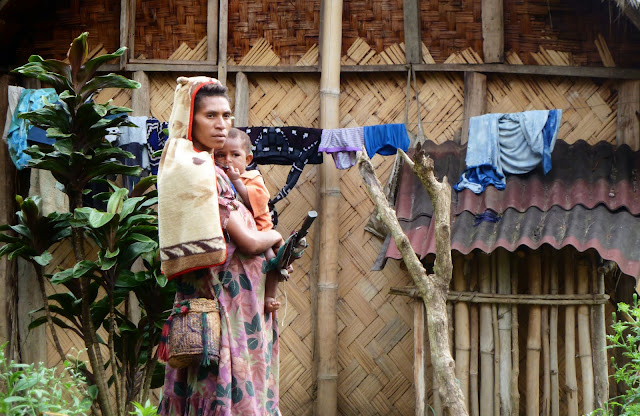A couple of weeks ago our friends in the village were doing a "singsing" in another village and invited us up the morning of to see them prep for it. A "singsing" is usually held in celebration of an event and is a blend of traditional dancing and singing, while dressed up in the style of that particular area. I've been to a lot of singsings but never understood the hours of prep that it took beforehand. It was one of the highlights of my time here to get "behind the scenes" and see what goes on. There was a specific process for every piece of "bilas" (decoration) they put on, and it made me curious what the meaning and importance of each piece was. I didn't ask too many questions as they were pretty focused on getting ready, so I just enjoyed the process. Above is my friend, Rose, who also works on our campus in the main kitchen.
Different headpieces to choose from, conveniently stored on a banana stalk. Most of these are made from either bird feathers or entire birds, including Bird of Paradise.
Headpieces stuck in a wall until needed.
I'm pretty sure their ancestors didn't use sunglasses, but at every singsing I've been to in our area the ladies wear them with their bilas.
Efeke also works on our campus and lives close by. Out of all the ladies in our area, I'm not sure how they decide who gets to be involved in the singsing but Efeke was sitting this one out.
I'm not sure who this lady is but she's a lot taller than others in our area and has a different look. Makes me wonder if she married in from a different area.
Kotile does security for us at Interface and he's rarely seen without his cowboy hat. I always think he has such bright and kind eyes.
There's little Annie on the left, hanging out with her friends. Just an ordinary day in the village for her.
I'd never put too much thought into how all their headdresses stayed in place, and have to admit I was shocked to see all that was involved. They begin by tying thin pieces of bark rope into the hair to start as a base to attach things to. Ouch!
A woven cap (made from plant fiber rolled into rope) is held in place by a stick that's run through it and the bark rope tied to the hair underneath. The first head piece is then added, taking two men to get it on. You can tell by Janet's face that this isn't the most comfortable process.
More head pieces to choose from.
Sese watches from up on the hill. She was my very first language helper when I got to Interface.
Random items adorn a window.
I decided to stop standing around looking like a tourist and looked for a way to make myself useful. More often than not we tend to mess things up more than help (humility is learned pretty quickly here), but these ladies were crimping pieces of plants to be used for bilas and it looked easy enough to help with. Below are some other plants that were crimped for decoration.
Heti uses a kids' paint set to touch up his wife, Janet. Whatever works!
 Another case of "whatever works" - a flip flop sole with feathers stuck in it. It's attached on a piece of coiled wire for some bounce.
Another case of "whatever works" - a flip flop sole with feathers stuck in it. It's attached on a piece of coiled wire for some bounce.
And in case you were looking for a use for leftover ginger and coconut husk, they hold head pieces in place pretty well.
One of the ladies refused to let me get a picture of her holding a mirror. There are traditional beliefs here that we often know nothing about until we stumble on something like this. I asked my friend Janet why the mirror would be a problem (I had heard of reasons why in other cultures) and she didn't seem to know. Sometimes they genuinely don't know, but other times they just don't want to talk about it. I find if I come right out and ask a "why" question I don't get the most open response. But when you spend time with people and have a genuine relationship, tidbits of their culture will come up in conversation naturally and I love discovering new things I didn't know before.
These two guys, Kotile and Kokore, cracked me up. The men were the ones decorating all the women and it was neat to see them in action. You could tell they'd had years of experience doing this and there was a specific way for each headdress to be "built." Kokore (at right) seemed to be heading up the whole bilas department, and here he and Kotile were discussing differences of opinion as to what head piece was supposed to go next.
Kokore and his wife, Mena. Notice the mop used for Mena's dress. These two are a part of the small Bena church here and they wanted their picture taken together. They're probably the age of my grandparents, and it's amusing thinking of either of my grandmas in anything remotely close to this. :0)
People watch as everyone loads into the vehicle.
We couldn't believe how many people they got packed into the truck, and we had to laugh at all the feathers sticking out everywhere.
One last photo op heading down the hill to go home.































Great post, Yulie!
ReplyDeleteamazing photos julie! thanks for letting us go behind the scenes with you. so thankful He sent you there. your love for these people shines through.
ReplyDelete